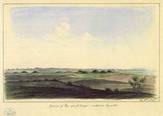- Steering group and management
- Sub-projects
- Jelling in GIS (Geographic Information System)
- Geophysical survey at Jelling
- Fieldwork 2011
- Archaeological fieldwork 2010
- Archaeological fieldwork 2009
- Jelling’s large stones
- The landscape around Jelling
- Place names in Jelling and its vicinity
- The bridge over Ravning Enge
- The travertine churches of East Jutland.
- Rune stones in context 2011
- Power and coins 2009
- Exhibitions
- Digitizing the photographs
Jelling North 2009
During the magnetometer survey in 2006 north and north-east of the North Mound at Jelling, archaeologists uncovered a concentration of large stones, which are interpreted as part of an enormous ship-setting. In the subsequent excavations of the area a number of post holes and a palisade were uncovered. The site of a house with sturdy, bowed walls was suggested. Evidence of four buildings and several fence lines were revealed. The fence was considerably more substantial than usual, when compared to other Viking Age buildings from Denmark, which points a special type of building.
Objective
The investigations of 2006 and 2007 failed to give a clear result. The houses and the fence cover different periods. In addition, the various finds from a metal detector survey and electromagnetic measurements do not paint a clear picture of settlement near the monuments at Jelling. In 2009 an investigation involving trial trenches begins in the fields north of Jelling. This aims to establish whether traces of activity from the Viking Age can be found and to define the extent of the settlement.
Project coordinator: Assistant Professor Mads Kähler Holst, Aarhus University in cooperation with Museum Inspector Steen Wulff Andersen, Vejle Museum.
Magnetometer survey
A magnetometer survey involves using a magnetometer to record anomalies in the earth’s natural magnetic field. The anomalies can be caused by objects or features with magnetic properties in the upper ground layer. These can include burnt stone, slag from an iron smelting furnace, large stones, posts, graves or ditches.



